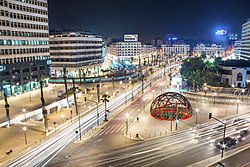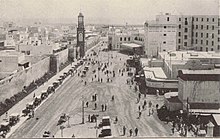
Casablanca is the largest city in Morocco and the country's economic and business centre. Located on the Atlantic coast of the Chaouia plain in the central-western part of Morocco, the city has a population of about 3.71 million in the urban area, and over 4.27 million in Greater Casablanca, making it the most populous city in the Maghreb region, and the eighth-largest in the Arab world.
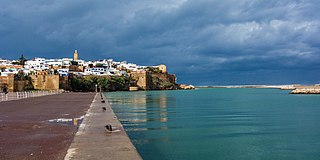
Rabat is the capital city of Morocco and the country's seventh-largest city with an urban population of approximately 580,000 (2014) and a metropolitan population of over 1.2 million. It is also the capital city of the Rabat-Salé-Kénitra administrative region. Rabat is located on the Atlantic Ocean at the mouth of the river Bou Regreg, opposite Salé, the city's main commuter town.

The history of the city of Casablanca in Morocco has been one of many political and cultural changes. At different times it has been governed by Berber, Roman, Arab, Portuguese, Spanish, French, British, and Moroccan regimes. It has had an important position in the region as a port city, making it valuable to a series of conquerors during its early history.
Jean-François Zevaco was a French-Moroccan architect born in Casablanca. He is considered an emblematic figure of the modernist architectural movement in Morocco and in Africa, and his legacy is important in terms of the number of constructions built across Morocco, the diversity of his works, and their international aura.

The Casablanca Tramway is a low-floor tram system in Casablanca, Morocco. As of 2019, it consists of two lines - T1 from Sidi Moumen to Lissasfa, and T2 from Sidi Bernoussi to Aïn Diab—which intersect at 2 points and form a 47 km (29 mi) network with 71 stations. Two additional lines, T3 and T4, are scheduled to open in 2024.

Maurice Le Glay was a French Army officer and author of works on Morocco. He served as an artillery and political officer in Algeria, Tunisia and Morocco before retiring to a civil post in 1918 so that he could begin a literary career. He wrote numerous journal articles and several books including a description of the French defeat at the Battle of El Herri. He was a strong admirer of the Berber people, though he was criticised for inspiring the political division of the Berber and Arab peoples in Morocco. He retired to Casablanca, where he died and was honoured with a street named in his memory.

The National Library of the Kingdom of Morocco is located in Rabat, Morocco, with a branch in Tetouan. The former Bibliothèque Générale was created in 1924. In 2003, it was renamed the "Bibliothèque nationale du Royaume du Maroc."
The following is a timeline of the history of the city of Marrakesh, Morocco.

The Casablanca Clock Tower is a clock tower in Casablanca, Morocco. Located in United Nations Square, the tower is a 1993 reproduction of one of the oldest French-built structures in the city. The original tower was built in 1909 by the French commander Charles Martial Joseph Dessigny, and designed by Le Capitaine du Génie Bouillot, as an identical copy of one he had built in Aïn Séfra when stationed there previously.
Casamémoire is a non-profit organization dedicated to the promotion and protection of the 20th-century architecture of Casablanca, Morocco. As of 2015, Casamemoire is an NGO in an official partnership with UNESCO with consultative status.

Mohammed V Square is a public square of historical and symbolic significance located in central Casablanca, Morocco. It was established in 1916 at the beginning of the French protectorate in Morocco under Resident-general Hubert Lyautey, on a design by architects Henri Prost and Joseph Marrast.
The Wilaya Building is the building that houses the administration of Grand Casablanca. It was designed by Marius Boyer and built from 1928-1937 during the French Protectorate in Morocco. The building is located at Muhammad V Square in central Casablanca, Morocco, and it remains an emblematic building of the city's architecture.

The architecture of Casablanca is diverse and historically significant. Casablanca, Morocco's economic capital, has a rich urban history and is home to many notable buildings in a variety of styles. Throughout the 20th century, architecture and urban development in Casablanca evolved in a way that was simultaneously specific to the city's contexts, and consonant with international ideas.

Elie Azagury was an influential Moroccan architect and director of the Groupe des Architectes Modernes Marocains (GAMMA) after Moroccan independence in 1956. He is considered the first Moroccan modernist architect, with works in cities such as Casablanca, Tangier, and Agadir. Azagury was also a controversial and outspoken Communist, and was active designing cités, or social housing projects made up of modular units, in places like Hay Hassani in Casablanca. These projects combined elements of modern and vernacular architecture, taking local culture and lifestyles into account.
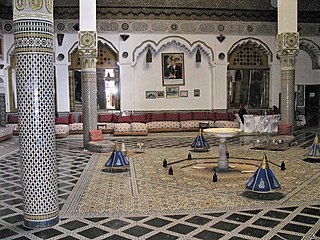
The Mnebhi Palace or Menebhi Palace, also known by its French name Palais Mnebhi, is a historic early 20th-century palace in Fes el-Bali, the old medina of Fes, Morocco. It is notable for both its lavish architecture as well as for being the place where the 1912 Treaty of Fes was officially signed. It is located on Tala'a Seghira street, one of the main souq streets of the city.
Abdelouahed Mountassir is a Moroccan architect and urban planner. He is mainly known for his designs of the National Library of the Kingdom of Morocco (2008), for the future Ibn Sina University Hospital in Rabat and for urban development projects in Rabat and Casablanca.
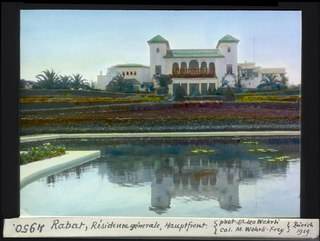
The French Protectorate Residence also known as Residence-general is a historic building in Rabat, Morocco. It was the seat of the Resident-general in the French protectorate in Morocco from its completion in 1924 to the end of the protectorate in 1956.

The Equestrian statue of Hubert Lyautey is a public sculpture that commemorates Hubert Lyautey, the first Resident-general of the French protectorate in Morocco, in Casablanca, Morocco.

The State Bank of Morocco was a quasi-central bank established in 1907 following the Algeciras Conference, to stabilize the Moroccan currency and serve as a vehicle for European and especially French influence in the Sultanate of Morocco. Following the independence of Morocco, it was replaced in 1959 by the newly created Banque du Maroc, known since 1987 as Bank Al-Maghrib.
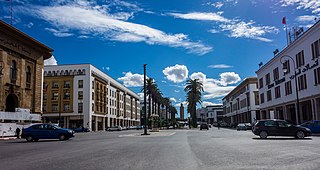
Avenue Mohammed V, sometimes referred to by its old name Avenue Dar al-Makhzen, is a major thoroughfare in downtown Rabat, Morocco. Its main section was created under the French Protectorate in Morocco and mostly developed between 1915 and 1932, when it was also known as Cours Lyautey. At the southern end of that section is the As-Sunna Mosque, whose history dates back to the 18th century like that of the nearby royal palace or Dar el-Makhzen.
